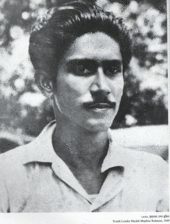East Pakistan Renaissance Society

The East Pakistan Renaissance Society was a political organisation formed to articulate and promote culturally and intellectually the idea for a separate Muslim state for Indian Muslims and specifically for the Muslims of Bengal.[1] The organisation's founders and leaders included Abul Kalam Shamsuddin, the society president, Muhammad Habibullah Bahar and Sheikh Mujibur Rahman.[1][2][3]
Foundation
The "Two-Nation Theory", which argued that the Hindus and Muslims of India were not a common nation and could not live together as a nation, had been propagated by Muslim politicians and intellectuals such as Sir Muhammad Iqbal, Choudhary Rahmat Ali and Muhammad Ali Jinnah, the president of the All India Muslim League.[4][5] The demand for a separate state for Indian Muslims took definite shape when the All India Muslim League adopted the Lahore Resolution (also known as the Pakistan Resolution) on March 23, 1940. The resolution called for the Muslim-majority provinces of British India to be constituted as separate, independent states – it did not specify a single state.[1]
At a meeting held on August 30, 1942 at the headquarters of the Dainik Azad newspaper in Kolkata (now Calcutta), Bengali Muslim activists decided to form the East Pakistan Renaissance Society as a platform to advocate the idea of a Muslim state on a cultural and intellectual basis. The Society's membership consisted of journalists, student activists, intellectuals and members of the Bengal Muslim League. The society held its first council at the Islamia College in Kolkata in 1944.
Philosophical differences

The Muslim League and most other advocates of Pakistan had demanded a single state of Pakistan consisting of the British Indian provinces of Punjab, Khyber Pakhtunkhwa (then Northwest Frontier Province), Sindh, Balochistan and Bengal, and sought the Urdu language to be the only official language and lingua franca of Muslims.[1] However, the East Pakistan Renaissance Society not only argued that Muslims were a separate nation from Hindus, it also advocated that the Bengali Muslims were distinct from the Muslims of other parts of India, on an ethnic, cultural and geographical basis.[1][3] Unlike religion, the society argued that ethnicity and cultural differences cannot cross geographic boundaries.[1][3] The society and its supporters in the Bengal Muslim League asserted that Bengali Muslims should constitute an independent state, as an "Eastern Pakistan" rather than part of a single state of Pakistan.[1][2] The society asserted the importance of the Bengali culture and language, which many advocates of Pakistan criticised as being "Hinduised" and "Sanskritised."[1][6]
Aftermath
The society dissolved after the partition of India in 1947, which also partitioned Bengal to create the Muslim-majority East Bengal (also known as East Pakistan), which became part of Pakistan; Hindu-majority West Bengal and Assam became part of India. Several of the society's leaders were leading activists in the Bengali language movement (1953-1956), which was a mass struggle in East Pakistan for the recognition of the Bengali language as the second official language of Pakistan, along with Urdu.[1][2][3] The society leader Sheikh Mujibur Rahman became the chief of the Awami League, which argued for greater autonomy for East Bengal and strengthening of Bengali culture, and subsequently spearheaded the Bangladesh Liberation War, which led to the independence of East Bengal from Pakistan, becoming the People's Republic of Bangladesh.[1][2][3]
References
- ↑ 1.0 1.1 1.2 1.3 1.4 1.5 1.6 1.7 1.8 1.9 Ian Talbott (1998). Pakistan: A Modern History. Palgrave Macmillan. pp. 88–92. ISBN 978-0-312-21606-1.
- ↑ 2.0 2.1 2.2 2.3 Harun-or-Rashid (2003). The foreshadowing of Bangladesh: Bengal Muslim League and Muslim politics, 1906-47. University Press. ISBN 978-984-05-1688-9.
- ↑ 3.0 3.1 3.2 3.3 3.4 Nagendra Kr. Singh (2003). Encyclopaedia of Bangladesh. Anmol Publications Pvt. Ltd. pp. 180–82. ISBN 978-81-261-1390-3.
- ↑ Robin W. Winks, Alaine M. Low (2001). The Oxford history of the British Empire: Historiography. Oxford University Press. ISBN 978-0-19-924680-9
- ↑ Liaquat Ali Khan (1940). Pakistan: The Heart of Asia. Thacker & Co. Ltd. ISBN 978-1-4437-2667-2
- ↑ Oldenburg, Philip (August 1985). ""A Place Insufficiently Imagined": Language, Belief, and the Pakistan Crisis of 1971". The Journal of Asian Studies (The Journal of Asian Studies, Vol. 44, No. 4) 44 (4): 711–733. doi:10.2307/2056443. ISSN 0021-9118. JSTOR 2056443.
| |||||||||||||||||||||||||||||
